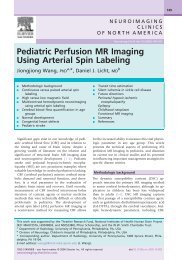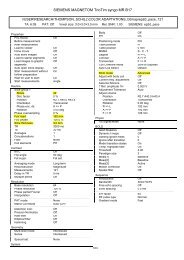Arterial Spin Labeling Perfusion MRI Signal Processing Toolbox ...
Arterial Spin Labeling Perfusion MRI Signal Processing Toolbox ...
Arterial Spin Labeling Perfusion MRI Signal Processing Toolbox ...
Create successful ePaper yourself
Turn your PDF publications into a flip-book with our unique Google optimized e-Paper software.
3.1.1.1 Reset the orientations<br />
Click “Reset..” button (as shown as ① in figure 3.1) and select all the images to be processed<br />
including the structure images and the functional images. This would retain the current voxel sizes and<br />
sets the origins of the images to the center of the volumes and set all the rotations back to zero.<br />
3.1.1.2 Find the Anterior Commissure<br />
Display one of the origin reset images. Click the horizontal bar (② in figure 3.1) to check if the origin,<br />
which is indicated by the crosshair in the three views, is in the center of each view. If not, please do step<br />
3.1.1.1 again.<br />
Click around the three views until the crosshair is at the Anterior Commissure(③ in figure 3.1).<br />
Illustrations for finding the Anterior Commissure can be also got from the following webpage:<br />
http://imaging.mrc-cbu.cam.ac.uk/imaging/FindingCommissures.<br />
The offset between the center of the volume (the current origin after “reset”) and the Anterior<br />
Commissure (the location of the cursor) will show in the box “mm” (④ in figure 3.1).<br />
3.1.1.3 Reorient images<br />
Once you have moved the cursor to the desired “origin” place, you will notice the offset between the<br />
current cursor position to current “origin” of the displayed MR image (which is the center of the volume in<br />
this example). Now, you can reorient the images by entering the NEGATIVEs of the x, y, z coordinates<br />
(shown in the “mm” box) to the boxes named “right” , “forward” , “up” (⑤ in figure 3.1), respectively.<br />
Then click the “Reorient images...” button (⑥ in figure 3.1) and select the images to which the new<br />
origins should be applied to. This will change the affine transformation matrix in the image header in<br />
SPM > 5.<br />
3.2 Motion correction (NEW)<br />
ASL data should be motion corrected for the control and label image series separately [1]. But that<br />
requires additional coregistration between these two series. We have adapted the motion correction<br />
function provided in SPM to avoid treating the zig-zagged spin labeling paradigm as additional motions<br />
[2]. See batch_realign.m for the details.<br />
3.3 Coregistration between ASL images and the structure images.<br />
ASL images should be coregistered to anatomical images so they can be later normalized to the MNI<br />
space (or local template space or any other standard space) for group analysis. The target image and<br />
source image should be selected as the T1 image and the mean ASL raw image, respectively. T2 weight<br />
structure images can be used as well.<br />
10






